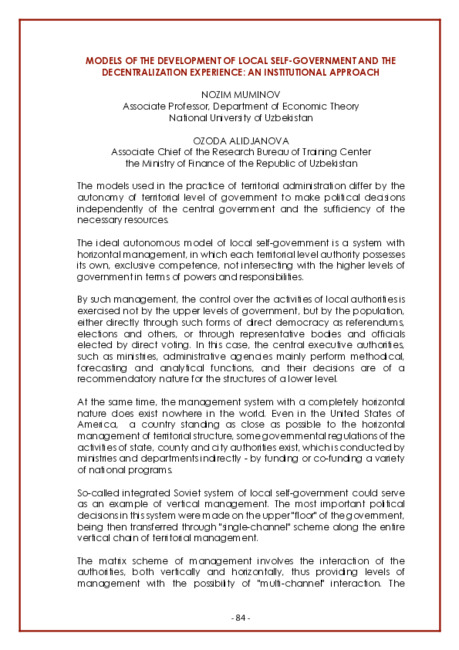
- 84 -
MODELS OF THE DEVELOPMENT OF LOCAL SELF-GOVERNMENT AND THE
DECENTRALIZATION EXPERIENCE: AN INSTITUTIONAL APPROACH
NOZIM MUMINOV
Associate Professor, Department of Economic Theory
National University of Uzbekistan
OZODA ALIDJANOVA
Associate Chief of the Research Bureau of Training Center
the Ministry of Finance of the Republic of Uzbekistan
The models used in the practice of territorial administration differ by the
autonomy of territorial level of government to make political decisions
independently of the central government and the sufficiency of the
necessary resources.
The ideal autonomous model of local self-government is a system with
horizontal management, in which each territorial level authority possesses
its own, exclusive competence, not intersecting with the higher levels of
government in terms of powers and responsibilities.
By such management, the control over the activities of local authorities is
exercised not by the upper levels of government, but by the population,
either directly through such forms of direct democracy as referendums,
elections and others, or through representative bodies and officials
elected by direct voting. In this case, the central executive authorities,
such as ministries, administrative agencies mainly perform methodical,
forecasting and analytical functions, and their decisions are of a
recommendatory nature for the structures of a lower level.
At the same time, the management system with a completely horizontal
nature does exist nowhere in the world. Even in the United States of
America, a country standing as close as possible to the horizontal
management of territorial structure, some governmental regulations of the
activities of state, county and city authorities exist, which is conducted by
ministries and departments indirectly - by funding or co-funding a variety
of national programs.
So-called integrated Soviet system of local self-government could serve
as an example of vertical management. The most important political
decisions in this system were made on the upper "floor" of the government,
being then transferred through "single-channel" scheme along the entire
vertical chain of territorial management.
The matrix scheme of management involves the interaction of the
authorities, both vertically and horizontally, thus providing levels of
management with the possibility of "multi-channel" interaction. The

- 85 -
horizontal interaction acquires great importance under these conditions;
between departments within a single governing structure, between
various
autonomous
levels
of
management
(inter-municipal
cooperation).
Thereby, there are four systems of local government are distinguished:
•
Anglo-Saxon model;
•
French or Napoleonic model;
•
German or mixed model;
•
Soviet integrated model.
The Anglo-Saxon model includes a certain amount of latitude for
municipalities, and the absence of specifically authorized state officials
controlling the executive bodies at the local level, with management
predominantly possessing a horizontal nature. This type of management is
common in English-speaking countries such as Great Britain, the United
States of America, Canada, Australia, etc.
The French model assumes a local public official responsible for
coordination of the activities of public services. Often, these public officers
are entitled to control the activities of local self-government. With this
scheme of management, a vertical of public administration operates
simultaneously with the system of horizontal decentralized management
which deals with the issues of the territory life-support. Elements of the
French model are used in France, countries of Scandinavia, Latin America,
etc.
The German model combines the features of both models mentioned
above. Thus, the simultaneous existence of municipalities as the form of
territorial administration and government districts without elected local
authorities is adopted in Germany and Austria. In Germany, alongside this,
the right of communities to interact horizontally, thus forming various
municipal intercommunal unions for joint management is legislated.
Involvement of the one governing officer is allowed to manage such
agglomerations of communities, thereby considerably cutting down costs
for the maintenance of the administrative apparatus.
All three models, to some extent, incorporate elements of the matrix,
vertical and horizontal models of management.
The Soviet integrated model is a system of territorial management,
primarily based on vertical management.
In the frames of the research, it would be most appropriate to investigate
the experience of decentralization of government in the countries of

- 86 -
Eastern Europe and the CIS in depth, since this experience is closest to
Uzbekistan.
Summarizing the analysis of the process and results of decentralization, it
can be noted that there is a direct dependency between political, legal
and economic factors. The criterion for the overall assessment of the
degree of decentralization is the distribution of functions (or financial
responsibility) for the provision of public services between levels of
government. This criterion is one of the main indicators of fiscal
decentralization, along with the distribution of income, intergovernmental
transfers, the system of borrowings of local governments, etc. It should be
noted that such distribution of responsibilities is quite monotonous and
requires further development in the direction of a delegation of greater
empowerment to the local level as well as towards the application of
various forms and the performance modalities of functions of public
administration.






